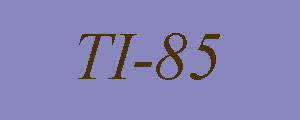
Graphics Calculators in Calculus
This site contains information and links related to the
use of graphics calculators in calculus courses. The descriptions
specifically relate to Texas Instruments' TI-85 calculator but other graphing
calculators may be analyzed by similar procedures. The TI-85 programming language
is very similar to BASIC. For the most part, it's quite easy to decipher and
transcribe this language into
programming languages for other graphics calculators. One reference
which compares programs for different calculators is
the book Graphing Calculator Laboratory Manual for Calculus
by F. Demana and B. Waits (Addison-Wesley, 1993).
Some information:
Here are source codes for some interesting and/or useful elementary programs
for the TI-85:
To type these codes into the TI-85, select "EDIT" from the "PRGM" menu, and
start by entering the program name.
The code can then be typed in letter by letter. There is a program
editing menu (the default menu when you enter program edit mode) which
has some useful shortcuts and editing options available.
Most of the commands and elementary functions can be most quickly entered by
making appropriate choices from various menus.
For example, "Input", "ClLCD" and "DispG" are in the "I/O" menu; while
"Lbl", "For" and "End" are in the "CTL" menu. ("I/O" and "CTL" are submenus
in the default program editing menu.)
Inequalites can be found in the "TEST" menu (located in the second from bottom
row of keys on the TI-85). The arrow "->" is obtained using the "STO>"
button (located on the left side of the second-from-bottom row of the key pad).
The "CATALOG" menu is an alphabetized list of choices -- if you're not
sure where to find a particular command or function, its almost certain
to be on this menu.
For more detailed information on creating programs, be sure to read the
TI-85 Owner's Guidebook.
There are numerous internet resources for the TI-85. Some starting points are:
This document was created in September, 1996 and last revised on
Nov. 18, 1998.
Your questions, comments or suggestions are welcomed.
Please direct correspondence to:
URL: http://www.math.ou.edu/~amiller/ti85/ti85.htm
Department of Mathematics
University of Oklahoma
e-mail: amiller@ou.edu